cruise control TOYOTA RAV4 1996 Service Owner's Manual
[x] Cancel search | Manufacturer: TOYOTA, Model Year: 1996, Model line: RAV4, Model: TOYOTA RAV4 1996Pages: 1632, PDF Size: 41.64 MB
Page 527 of 1632
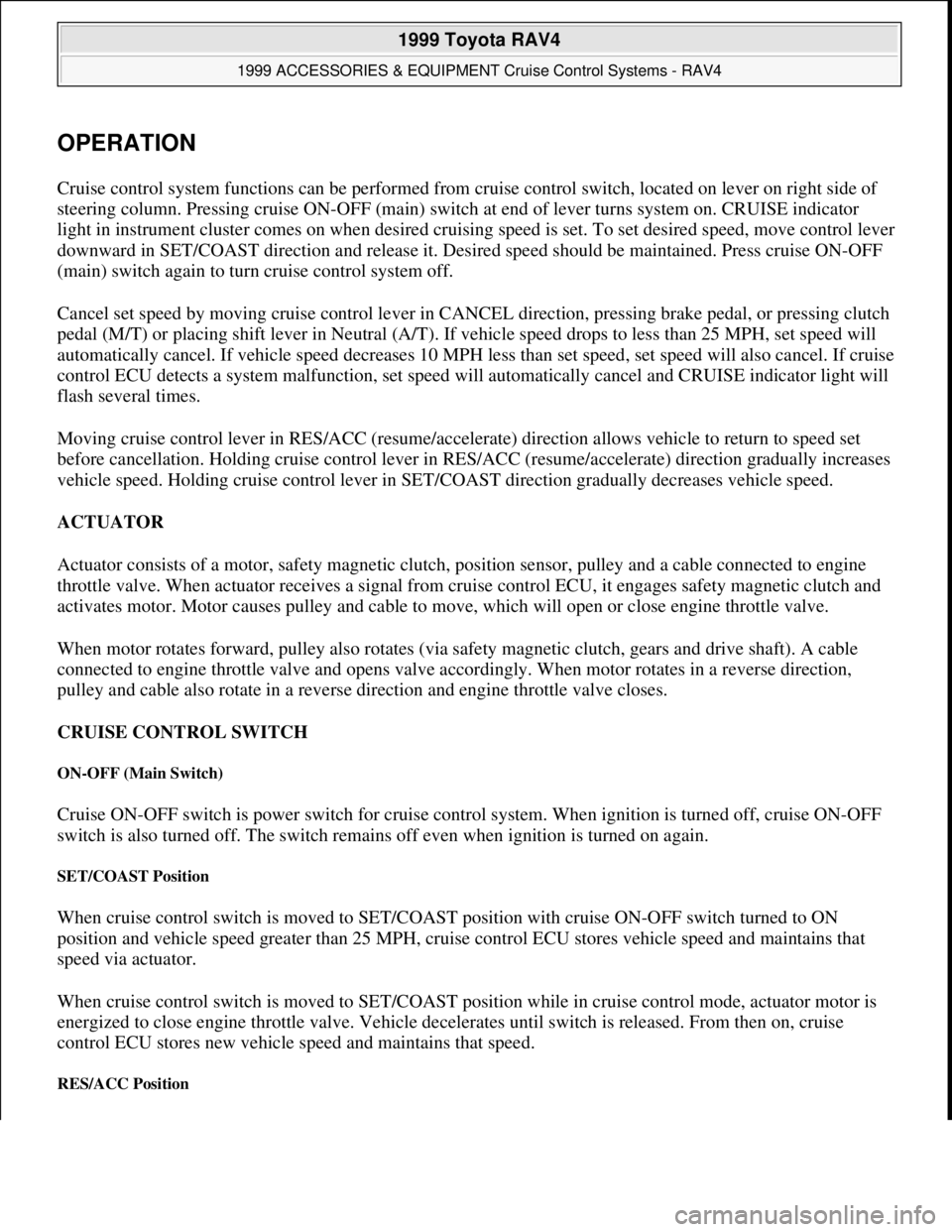
OPERATION
Cruise control system functions can be performed from cruise control switch, located on lever on right side of
steering column. Pressing cruise ON-OFF (main) switch at end of lever turns system on. CRUISE indicator
light in instrument cluster comes on when desired cruising speed is set. To set desired speed, move control lever
downward in SET/COAST direction and release it. Desired speed should be maintained. Press cruise ON-OFF
(main) switch again to turn cruise control system off.
Cancel set speed by moving cruise control lever in CANCEL direction, pressing brake pedal, or pressing clutch
pedal (M/T) or placing shift lever in Neutral (A/T). If vehicle speed drops to less than 25 MPH, set speed will
automatically cancel. If vehicle speed decreases 10 MPH less than set speed, set speed will also cancel. If cruise
control ECU detects a system malfunction, set speed will automatically cancel and CRUISE indicator light will
flash several times.
Moving cruise control lever in RES/ACC (resume/accelerate) direction allows vehicle to return to speed set
before cancellation. Holding cruise control lever in RES/ACC (resume/accelerate) direction gradually increases
vehicle speed. Holding cruise control lever in SET/COAST direction gradually decreases vehicle speed.
ACTUATOR
Actuator consists of a motor, safety magnetic clutch, position sensor, pulley and a cable connected to engine
throttle valve. When actuator receives a signal from cruise control ECU, it engages safety magnetic clutch and
activates motor. Motor causes pulley and cable to move, which will open or close engine throttle valve.
When motor rotates forward, pulley also rotates (via safety magnetic clutch, gears and drive shaft). A cable
connected to engine throttle valve and opens valve accordingly. When motor rotates in a reverse direction,
pulley and cable also rotate in a reverse direction and engine throttle valve closes.
CRUISE CONTROL SWITCH
ON-OFF (Main Switch)
Cruise ON-OFF switch is power switch for cruise control system. When ignition is turned off, cruise ON-OFF
switch is also turned off. The switch remains off even when ignition is turned on again.
SET/COAST Position
When cruise control switch is moved to SET/COAST position with cruise ON-OFF switch turned to ON
position and vehicle speed greater than 25 MPH, cruise control ECU stores vehicle speed and maintains that
speed via actuator.
When cruise control switch is moved to SET/COAST position while in cruise control mode, actuator motor is
energized to close engine throttle valve. Vehicle decelerates until switch is released. From then on, cruise
control ECU stores new vehicle speed and maintains that speed.
RES/ACC Position
1999 Toyota RAV4
1999 ACCESSORIES & EQUIPMENT Cruise Control Systems - RAV4
Microsoft
Sunday, November 22, 2009 10:52:01 AMPage 3 © 2005 Mitchell Repair Information Company, LLC.
Page 528 of 1632
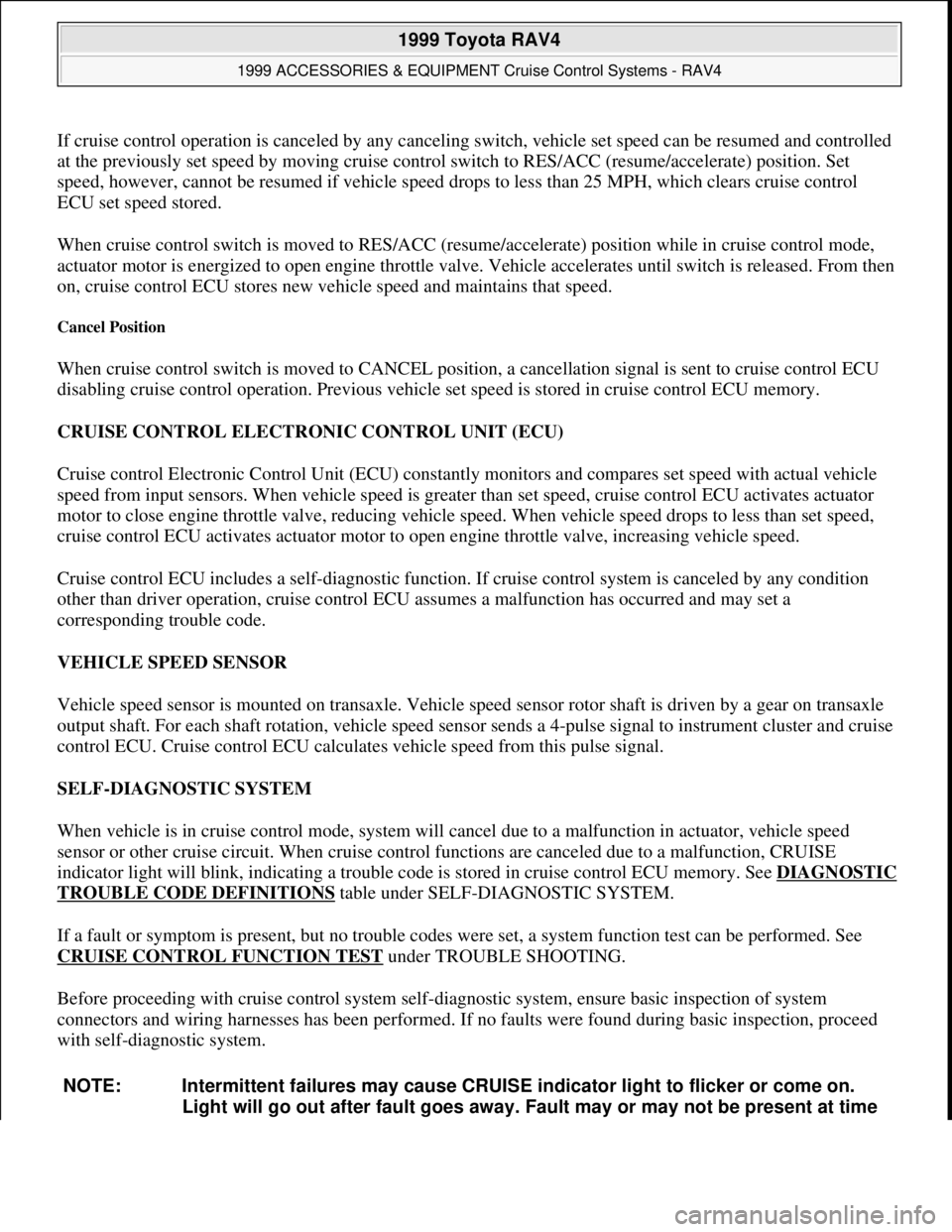
If cruise control operation is canceled by any canceling switch, vehicle set speed can be resumed and controlled
at the previously set speed by moving cruise control switch to RES/ACC (resume/accelerate) position. Set
speed, however, cannot be resumed if vehicle speed drops to less than 25 MPH, which clears cruise control
ECU set speed stored.
When cruise control switch is moved to RES/ACC (resume/accelerate) position while in cruise control mode,
actuator motor is energized to open engine throttle valve. Vehicle accelerates until switch is released. From then
on, cruise control ECU stores new vehicle speed and maintains that speed.
Cancel Position
When cruise control switch is moved to CANCEL position, a cancellation signal is sent to cruise control ECU
disabling cruise control operation. Previous vehicle set speed is stored in cruise control ECU memory.
CRUISE CONTROL ELECTRONIC CONTROL UNIT (ECU)
Cruise control Electronic Control Unit (ECU) constantly monitors and compares set speed with actual vehicle
speed from input sensors. When vehicle speed is greater than set speed, cruise control ECU activates actuator
motor to close engine throttle valve, reducing vehicle speed. When vehicle speed drops to less than set speed,
cruise control ECU activates actuator motor to open engine throttle valve, increasing vehicle speed.
Cruise control ECU includes a self-diagnostic function. If cruise control system is canceled by any condition
other than driver operation, cruise control ECU assumes a malfunction has occurred and may set a
corresponding trouble code.
VEHICLE SPEED SENSOR
Vehicle speed sensor is mounted on transaxle. Vehicle speed sensor rotor shaft is driven by a gear on transaxle
output shaft. For each shaft rotation, vehicle speed sensor sends a 4-pulse signal to instrument cluster and cruise
control ECU. Cruise control ECU calculates vehicle speed from this pulse signal.
SELF-DIAGNOSTIC SYSTEM
When vehicle is in cruise control mode, system will cancel due to a malfunction in actuator, vehicle speed
sensor or other cruise circuit. When cruise control functions are canceled due to a malfunction, CRUISE
indicator light will blink, indicating a trouble code is stored in cruise control ECU memory. See DIAGNOSTIC
TROUBLE CODE DEFINITIONS table under SELF-DIAGNOSTIC SYSTEM.
If a fault or symptom is present, but no trouble codes were set, a system function test can be performed. See
CRUISE CONTROL FUNCTION TEST
under TROUBLE SHOOTING.
Before proceeding with cruise control system self-diagnostic system, ensure basic inspection of system
connectors and wiring harnesses has been performed. If no faults were found during basic inspection, proceed
with self-diagnostic system.
NOTE: Intermittent failures may cause CRUISE indicator light to flicker or come on.
Light will go out after fault goes away. Fault may or may not be present at time
1999 Toyota RAV4
1999 ACCESSORIES & EQUIPMENT Cruise Control Systems - RAV4
Microsoft
Sunday, November 22, 2009 10:52:01 AMPage 4 © 2005 Mitchell Repair Information Company, LLC.
Page 529 of 1632
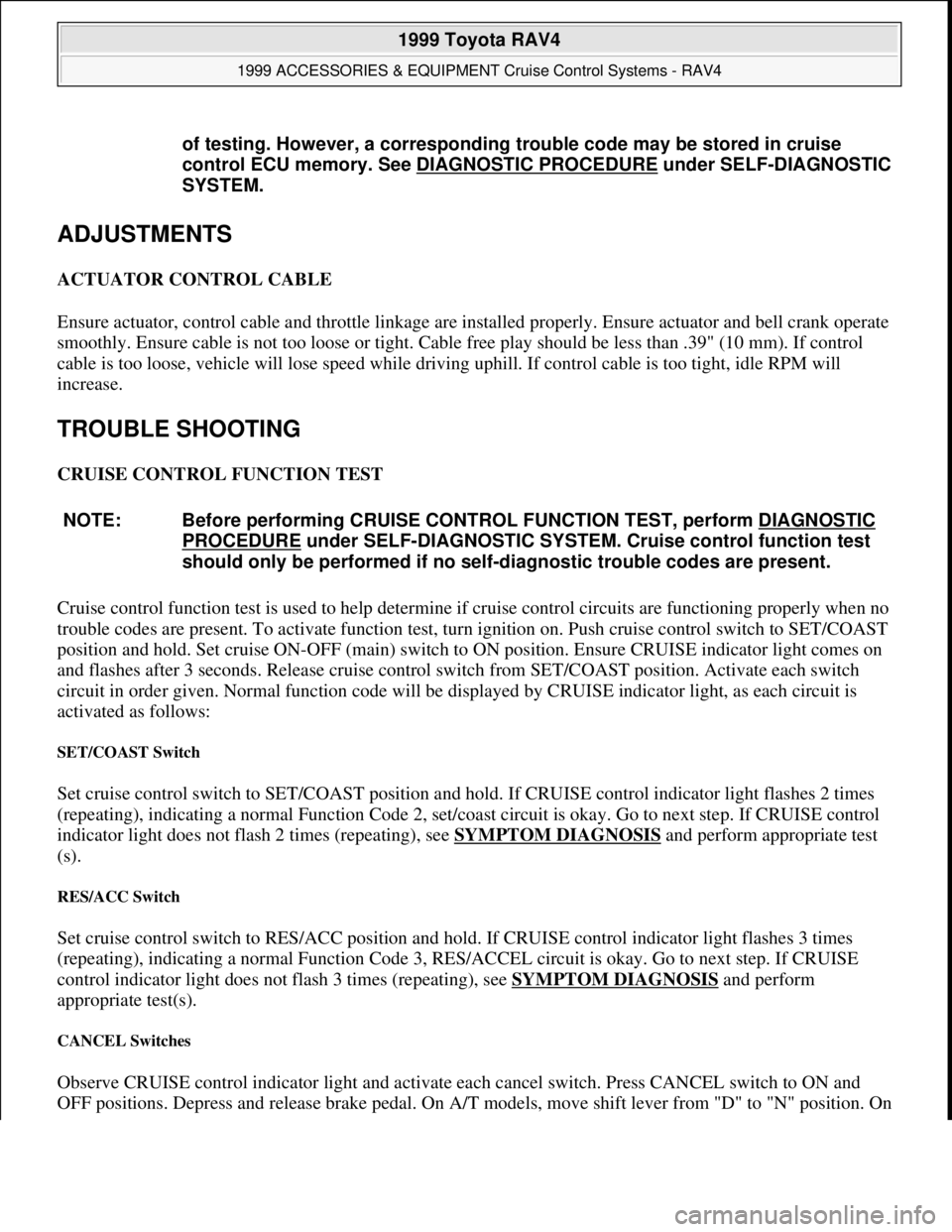
ADJUSTMENTS
ACTUATOR CONTROL CABLE
Ensure actuator, control cable and throttle linkage are installed properly. Ensure actuator and bell crank operate
smoothly. Ensure cable is not too loose or tight. Cable free play should be less than .39" (10 mm). If control
cable is too loose, vehicle will lose speed while driving uphill. If control cable is too tight, idle RPM will
increase.
TROUBLE SHOOTING
CRUISE CONTROL FUNCTION TEST
Cruise control function test is used to help determine if cruise control circuits are functioning properly when no
trouble codes are present. To activate function test, turn ignition on. Push cruise control switch to SET/COAST
position and hold. Set cruise ON-OFF (main) switch to ON position. Ensure CRUISE indicator light comes on
and flashes after 3 seconds. Release cruise control switch from SET/COAST position. Activate each switch
circuit in order given. Normal function code will be displayed by CRUISE indicator light, as each circuit is
activated as follows:
SET/COAST Switch
Set cruise control switch to SET/COAST position and hold. If CRUISE control indicator light flashes 2 times
(repeating), indicating a normal Function Code 2, set/coast circuit is okay. Go to next step. If CRUISE control
indicator light does not flash 2 times (repeating), see SYMPTOM DIAGNOSIS
and perform appropriate test
(s).
RES/ACC Switch
Set cruise control switch to RES/ACC position and hold. If CRUISE control indicator light flashes 3 times
(repeating), indicating a normal Function Code 3, RES/ACCEL circuit is okay. Go to next step. If CRUISE
control indicator light does not flash 3 times (repeating), see SYMPTOM DIAGNOSIS
and perform
appropriate test(s).
CANCEL Switches
Observe CRUISE control indicator light and activate each cancel switch. Press CANCEL switch to ON and
OFF positions. Depress and release brake pedal. On A/T models, move shift lever from "D" to "N" position. On of testing. However, a corresponding trouble code may be stored in cruise
control ECU memory. See DIAGNOSTIC PROCEDURE
under SELF-DIAGNOSTIC
SYSTEM.
NOTE: Before performing CRUISE CONTROL FUNCTION TEST, perform DIAGNOSTIC
PROCEDURE under SELF-DIAGNOSTIC SYSTEM. Cruise control function test
should only be performed if no self-diagnostic trouble codes are present.
1999 Toyota RAV4
1999 ACCESSORIES & EQUIPMENT Cruise Control Systems - RAV4
Microsoft
Sunday, November 22, 2009 10:52:01 AMPage 5 © 2005 Mitchell Repair Information Company, LLC.
Page 530 of 1632
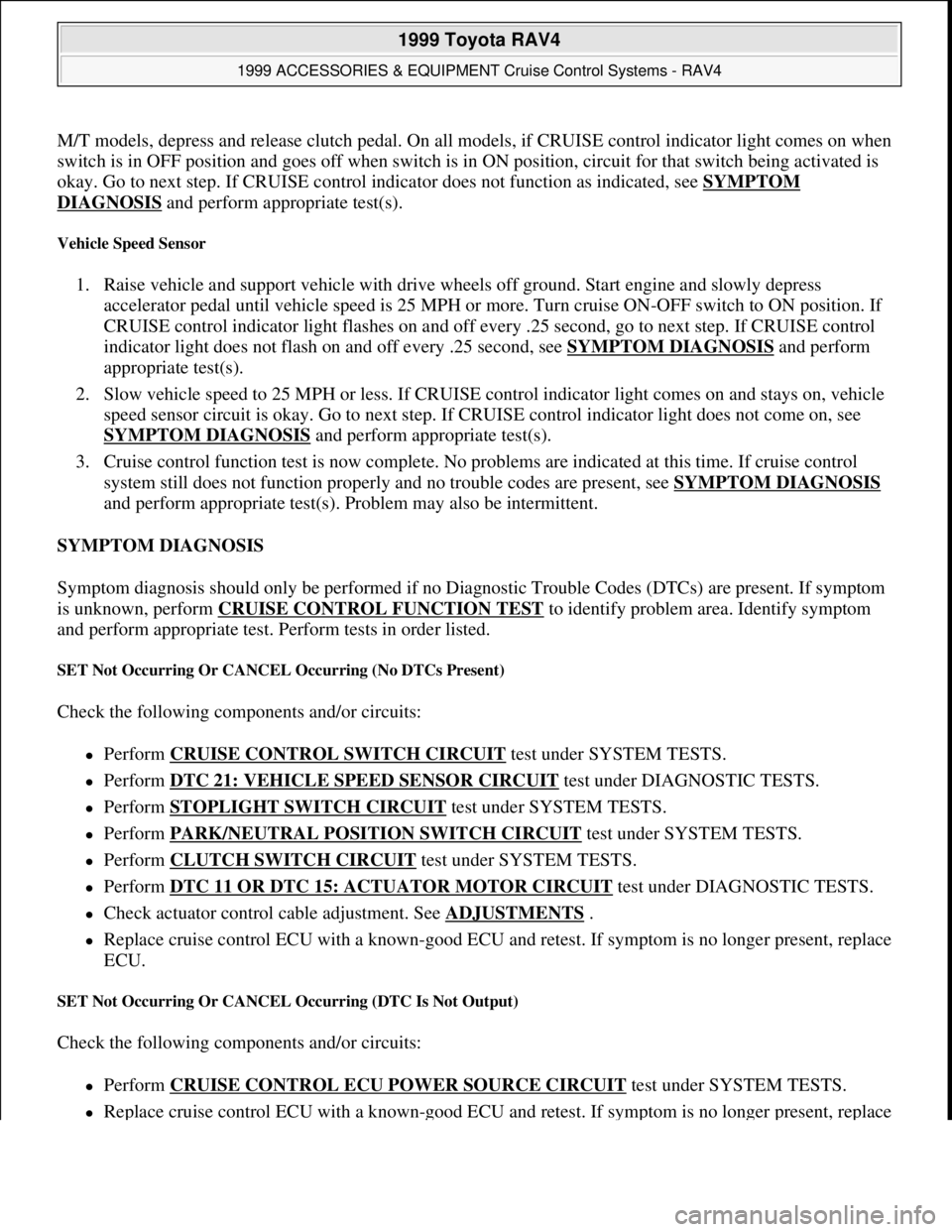
M/T models, depress and release clutch pedal. On all models, if CRUISE control indicator light comes on when
switch is in OFF position and goes off when switch is in ON position, circuit for that switch being activated is
okay. Go to next step. If CRUISE control indicator does not function as indicated, see SYMPTOM
DIAGNOSIS and perform appropriate test(s).
Vehicle Speed Sensor
1. Raise vehicle and support vehicle with drive wheels off ground. Start engine and slowly depress
accelerator pedal until vehicle speed is 25 MPH or more. Turn cruise ON-OFF switch to ON position. If
CRUISE control indicator light flashes on and off every .25 second, go to next step. If CRUISE control
indicator light does not flash on and off every .25 second, see SYMPTOM DIAGNOSIS
and perform
appropriate test(s).
2. Slow vehicle speed to 25 MPH or less. If CRUISE control indicator light comes on and stays on, vehicle
speed sensor circuit is okay. Go to next step. If CRUISE control indicator light does not come on, see
SYMPTOM DIAGNOSIS
and perform appropriate test(s).
3. Cruise control function test is now complete. No problems are indicated at this time. If cruise control
system still does not function properly and no trouble codes are present, see SYMPTOM DIAGNOSIS
and perform appropriate test(s). Problem may also be intermittent.
SYMPTOM DIAGNOSIS
Symptom diagnosis should only be performed if no Diagnostic Trouble Codes (DTCs) are present. If symptom
is unknown, perform CRUISE CONTROL FUNCTION TEST
to identify problem area. Identify symptom
and perform appropriate test. Perform tests in order listed.
SET Not Occurring Or CANCEL Occurring (No DTCs Present)
Check the following components and/or circuits:
Perform CRUISE CONTROL SWITCH CIRCUIT test under SYSTEM TESTS.
Perform DTC 21: VEHICLE SPEED SENSOR CIRCUIT test under DIAGNOSTIC TESTS.
Perform STOPLIGHT SWITCH CIRCUIT test under SYSTEM TESTS.
Perform PARK/NEUTRAL POSITION SWITCH CIRCUIT test under SYSTEM TESTS.
Perform CLUTCH SWITCH CIRCUIT test under SYSTEM TESTS.
Perform DTC 11 OR DTC 15: ACTUATOR MOTOR CIRCUIT test under DIAGNOSTIC TESTS.
Check actuator control cable adjustment. See ADJUSTMENTS .
Replace cruise control ECU with a known-good ECU and retest. If symptom is no longer present, replace
ECU.
SET Not Occurring Or CANCEL Occurring (DTC Is Not Output)
Check the following components and/or circuits:
Perform CRUISE CONTROL ECU POWER SOURCE CIRCUIT test under SYSTEM TESTS.
Replace cruise control ECU with a known-good ECU and retest. If symptom is no longer present, replace
1999 Toyota RAV4
1999 ACCESSORIES & EQUIPMENT Cruise Control Systems - RAV4
Microsoft
Sunday, November 22, 2009 10:52:01 AMPage 6 © 2005 Mitchell Repair Information Company, LLC.
Page 531 of 1632
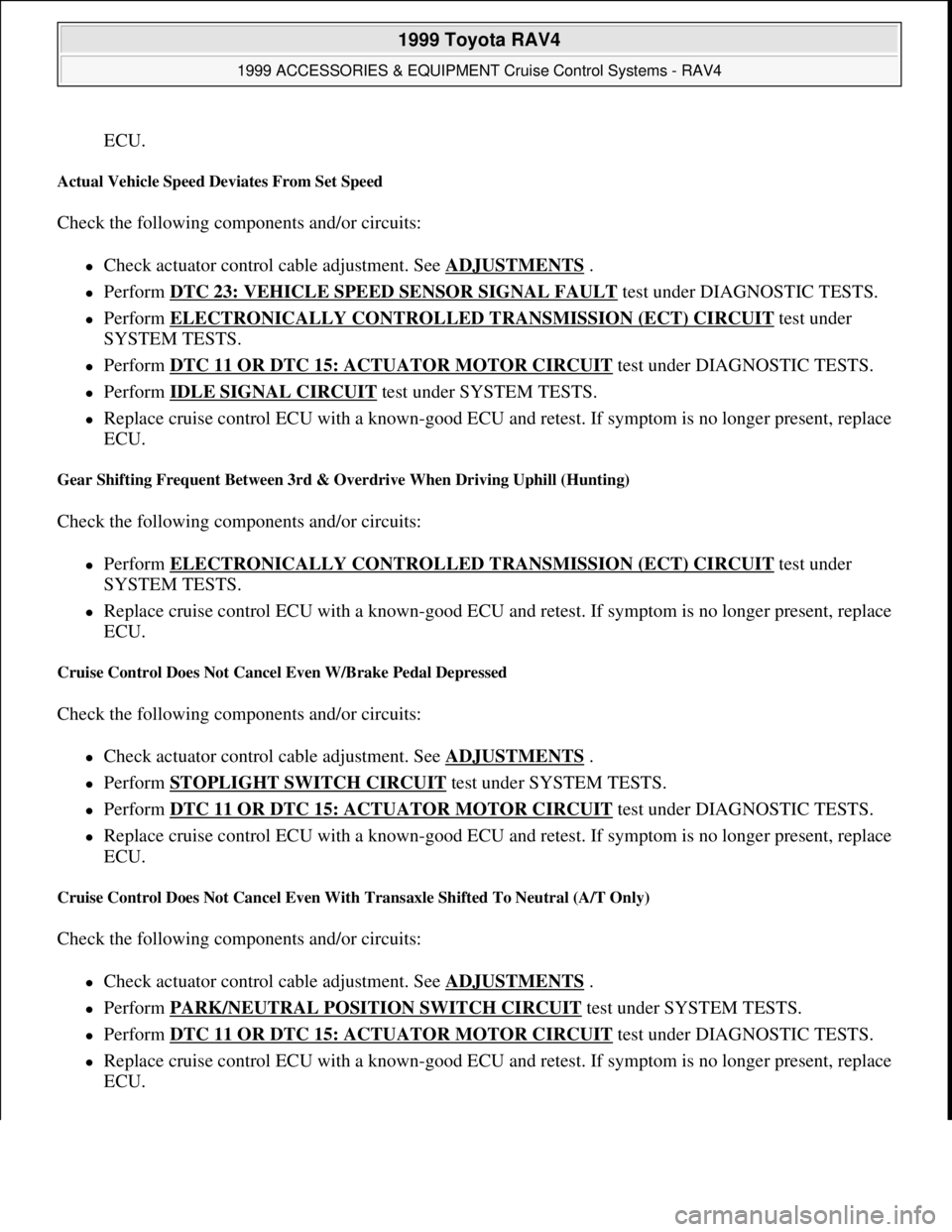
ECU.
Actual Vehicle Speed Deviates From Set Speed
Check the following components and/or circuits:
Check actuator control cable adjustment. See ADJUSTMENTS .
Perform DTC 23: VEHICLE SPEED SENSOR SIGNAL FAULT test under DIAGNOSTIC TESTS.
Perform ELECTRONICALLY CONTROLLED TRANSMISSION (ECT) CIRCUIT test under
SYSTEM TESTS.
Perform DTC 11 OR DTC 15: ACTUATOR MOTOR CIRCUIT test under DIAGNOSTIC TESTS.
Perform IDLE SIGNAL CIRCUIT test under SYSTEM TESTS.
Replace cruise control ECU with a known-good ECU and retest. If symptom is no longer present, replace
ECU.
Gear Shifting Frequent Between 3rd & Overdrive When Driving Uphill (Hunting)
Check the following components and/or circuits:
Perform ELECTRONICALLY CONTROLLED TRANSMISSION (ECT) CIRCUIT test under
SYSTEM TESTS.
Replace cruise control ECU with a known-good ECU and retest. If symptom is no longer present, replace
ECU.
Cruise Control Does Not Cancel Even W/Brake Pedal Depressed
Check the following components and/or circuits:
Check actuator control cable adjustment. See ADJUSTMENTS .
Perform STOPLIGHT SWITCH CIRCUIT test under SYSTEM TESTS.
Perform DTC 11 OR DTC 15: ACTUATOR MOTOR CIRCUIT test under DIAGNOSTIC TESTS.
Replace cruise control ECU with a known-good ECU and retest. If symptom is no longer present, replace
ECU.
Cruise Control Does Not Cancel Even With Transaxle Shifted To Neutral (A/T Only)
Check the following components and/or circuits:
Check actuator control cable adjustment. See ADJUSTMENTS .
Perform PARK/NEUTRAL POSITION SWITCH CIRCUIT test under SYSTEM TESTS.
Perform DTC 11 OR DTC 15: ACTUATOR MOTOR CIRCUIT test under DIAGNOSTIC TESTS.
Replace cruise control ECU with a known-good ECU and retest. If symptom is no longer present, replace
ECU.
1999 Toyota RAV4
1999 ACCESSORIES & EQUIPMENT Cruise Control Systems - RAV4
Microsoft
Sunday, November 22, 2009 10:52:01 AMPage 7 © 2005 Mitchell Repair Information Company, LLC.
Page 532 of 1632
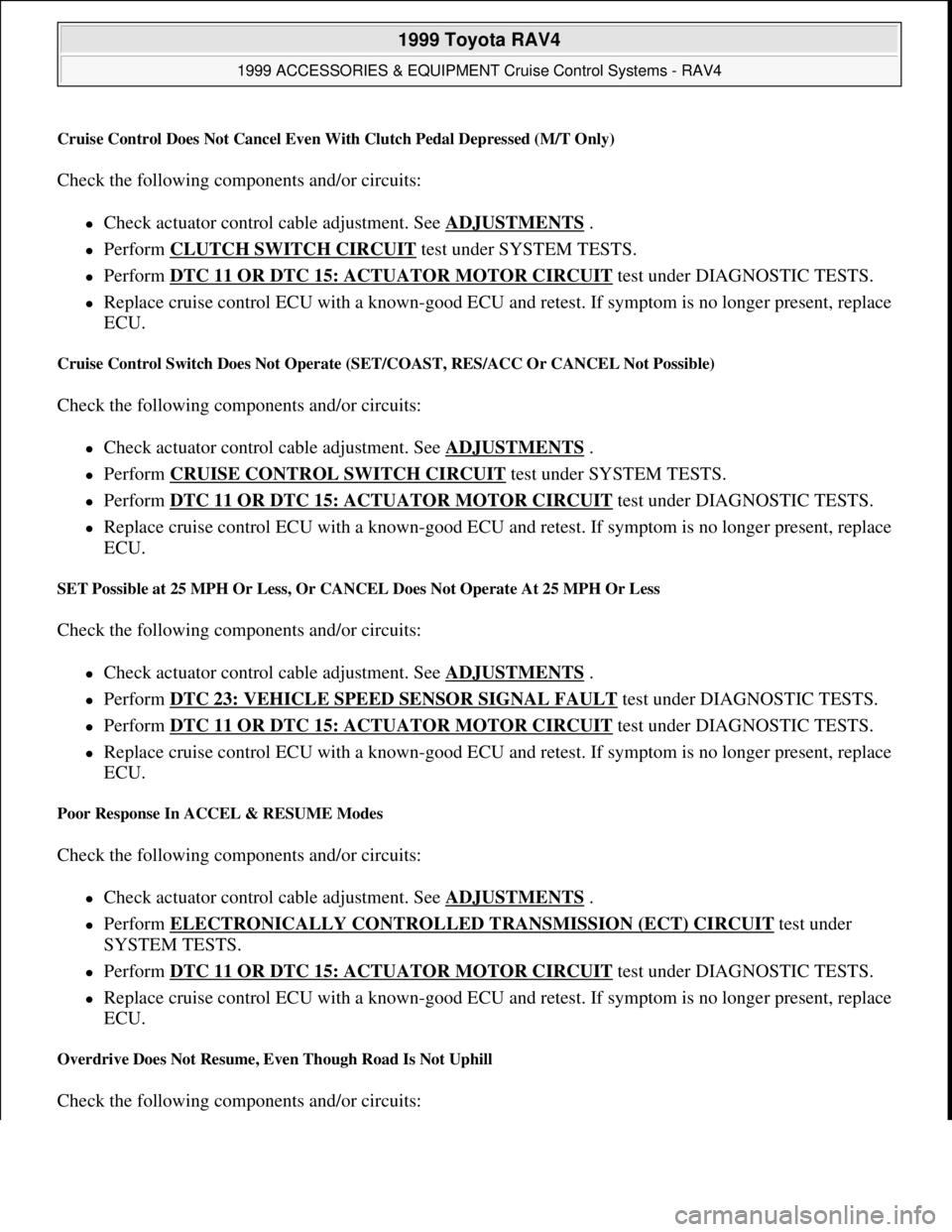
Cruise Control Does Not Cancel Even With Clutch Pedal Depressed (M/T Only)
Check the following components and/or circuits:
Check actuator control cable adjustment. See ADJUSTMENTS .
Perform CLUTCH SWITCH CIRCUIT test under SYSTEM TESTS.
Perform DTC 11 OR DTC 15: ACTUATOR MOTOR CIRCUIT test under DIAGNOSTIC TESTS.
Replace cruise control ECU with a known-good ECU and retest. If symptom is no longer present, replace
ECU.
Cruise Control Switch Does Not Operate (SET/COAST, RES/ACC Or CANCEL Not Possible)
Check the following components and/or circuits:
Check actuator control cable adjustment. See ADJUSTMENTS .
Perform CRUISE CONTROL SWITCH CIRCUIT test under SYSTEM TESTS.
Perform DTC 11 OR DTC 15: ACTUATOR MOTOR CIRCUIT test under DIAGNOSTIC TESTS.
Replace cruise control ECU with a known-good ECU and retest. If symptom is no longer present, replace
ECU.
SET Possible at 25 MPH Or Less, Or CANCEL Does Not Operate At 25 MPH Or Less
Check the following components and/or circuits:
Check actuator control cable adjustment. See ADJUSTMENTS .
Perform DTC 23: VEHICLE SPEED SENSOR SIGNAL FAULT test under DIAGNOSTIC TESTS.
Perform DTC 11 OR DTC 15: ACTUATOR MOTOR CIRCUIT test under DIAGNOSTIC TESTS.
Replace cruise control ECU with a known-good ECU and retest. If symptom is no longer present, replace
ECU.
Poor Response In ACCEL & RESUME Modes
Check the following components and/or circuits:
Check actuator control cable adjustment. See ADJUSTMENTS .
Perform ELECTRONICALLY CONTROLLED TRANSMISSION (ECT) CIRCUIT test under
SYSTEM TESTS.
Perform DTC 11 OR DTC 15: ACTUATOR MOTOR CIRCUIT test under DIAGNOSTIC TESTS.
Replace cruise control ECU with a known-good ECU and retest. If symptom is no longer present, replace
ECU.
Overdrive Does Not Resume, Even Though Road Is Not Uphill
Check the following components and/or circuits:
1999 Toyota RAV4
1999 ACCESSORIES & EQUIPMENT Cruise Control Systems - RAV4
Microsoft
Sunday, November 22, 2009 10:52:01 AMPage 8 © 2005 Mitchell Repair Information Company, LLC.
Page 533 of 1632
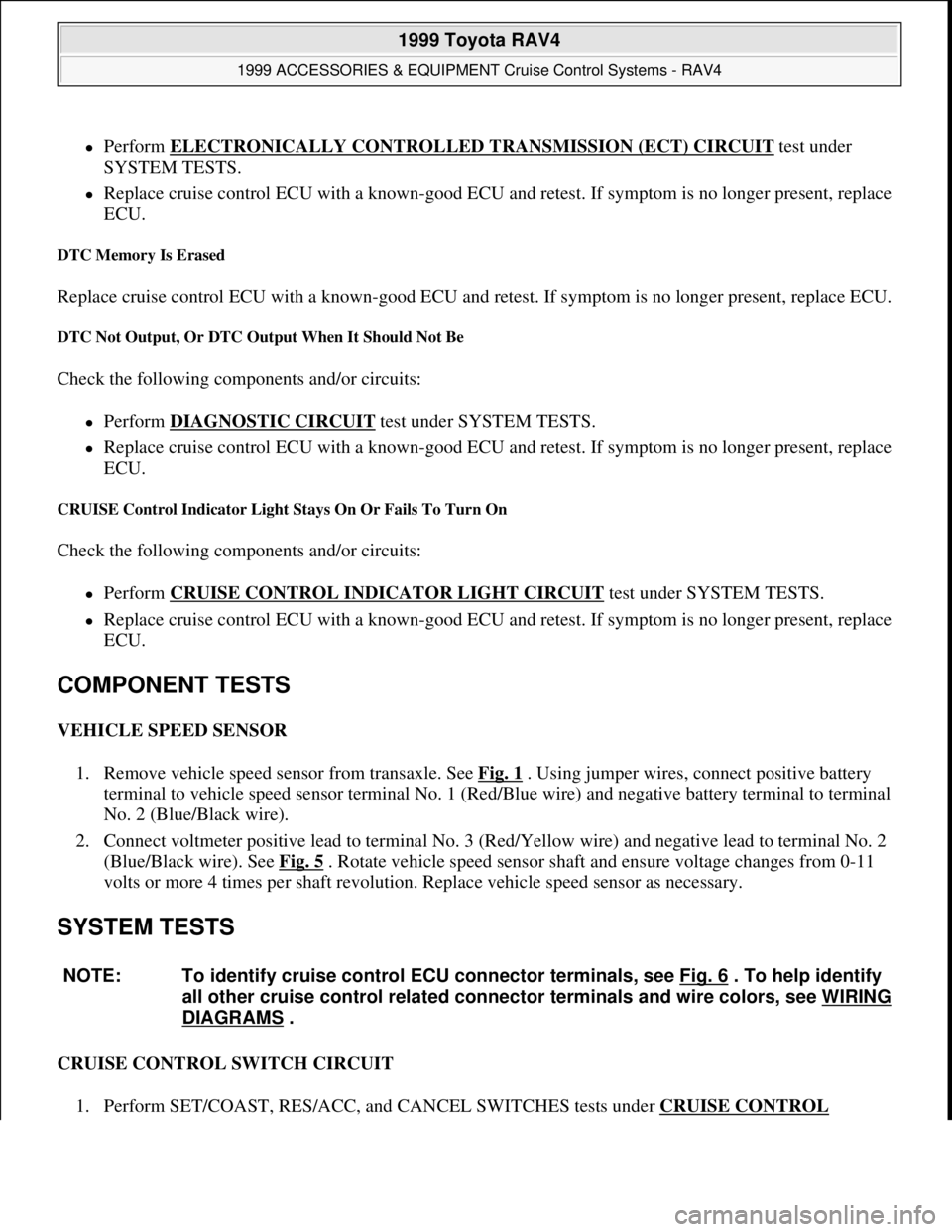
Perform ELECTRONICALLY CONTROLLED TRANSMISSION (ECT) CIRCUIT test under
SYSTEM TESTS.
Replace cruise control ECU with a known-good ECU and retest. If symptom is no longer present, replace
ECU.
DTC Memory Is Erased
Replace cruise control ECU with a known-good ECU and retest. If symptom is no longer present, replace ECU.
DTC Not Output, Or DTC Output When It Should Not Be
Check the following components and/or circuits:
Perform DIAGNOSTIC CIRCUIT test under SYSTEM TESTS.
Replace cruise control ECU with a known-good ECU and retest. If symptom is no longer present, replace
ECU.
CRUISE Control Indicator Light Stays On Or Fails To Turn On
Check the following components and/or circuits:
Perform CRUISE CONTROL INDICATOR LIGHT CIRCUIT test under SYSTEM TESTS.
Replace cruise control ECU with a known-good ECU and retest. If symptom is no longer present, replace
ECU.
COMPONENT TESTS
VEHICLE SPEED SENSOR
1. Remove vehicle speed sensor from transaxle. See Fig. 1
. Using jumper wires, connect positive battery
terminal to vehicle speed sensor terminal No. 1 (Red/Blue wire) and negative battery terminal to terminal
No. 2 (Blue/Black wire).
2. Connect voltmeter positive lead to terminal No. 3 (Red/Yellow wire) and negative lead to terminal No. 2
(Blue/Black wire). See Fig. 5
. Rotate vehicle speed sensor shaft and ensure voltage changes from 0-11
volts or more 4 times per shaft revolution. Replace vehicle speed sensor as necessary.
SYSTEM TESTS
CRUISE CONTROL SWITCH CIRCUIT
1. Perform SET/COAST, RES/ACC, and CANCEL SWITCHES tests under CRUISE CONTROL
NOTE: To identify cruise control ECU connector terminals, see Fig. 6 . To help identify
all other cruise control related connector terminals and wire colors, see WIRING
DIAGRAMS .
1999 Toyota RAV4
1999 ACCESSORIES & EQUIPMENT Cruise Control Systems - RAV4
Microsoft
Sunday, November 22, 2009 10:52:01 AMPage 9 © 2005 Mitchell Repair Information Company, LLC.
Page 534 of 1632
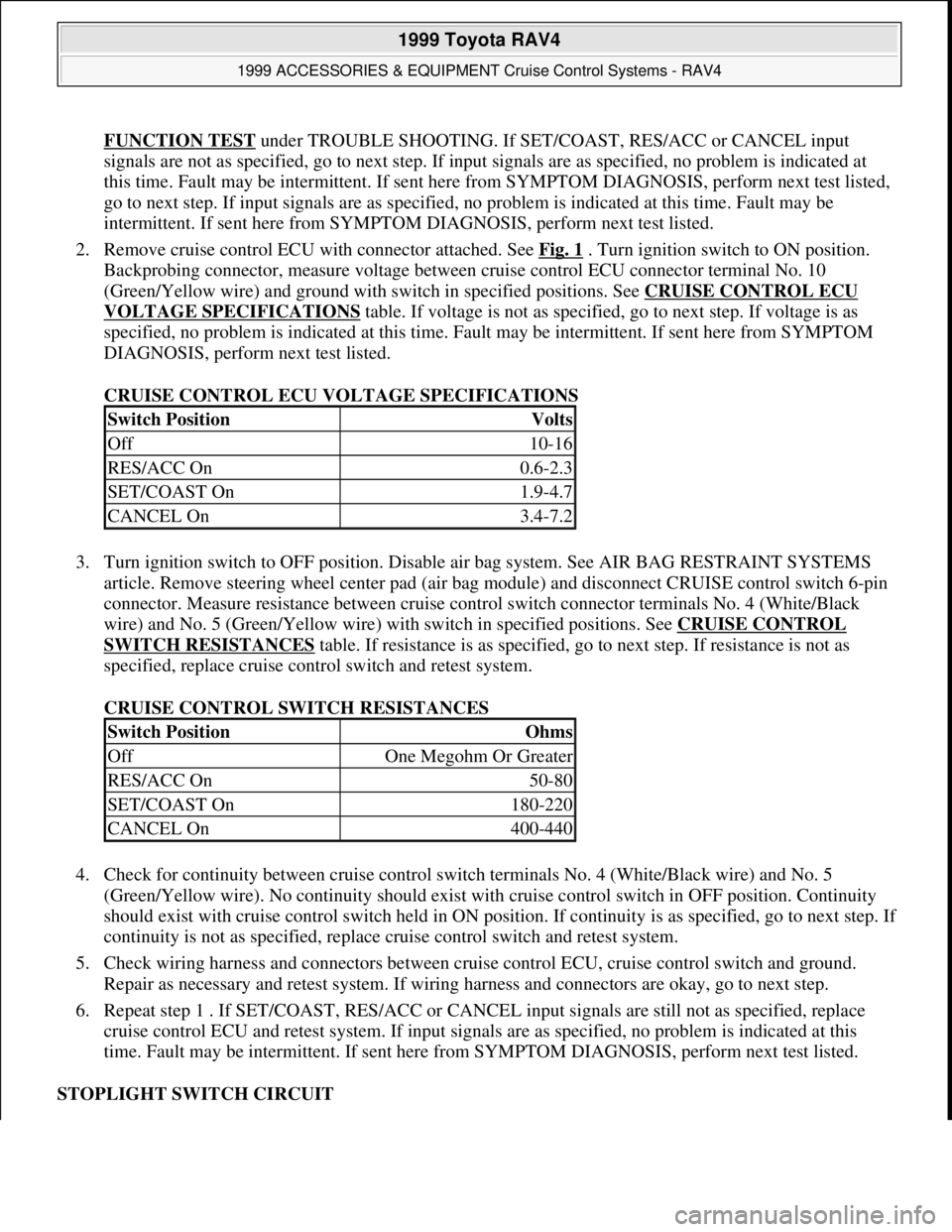
FUNCTION TEST under TROUBLE SHOOTING. If SET/COAST, RES/ACC or CANCEL input
signals are not as specified, go to next step. If input signals are as specified, no problem is indicated at
this time. Fault may be intermittent. If sent here from SYMPTOM DIAGNOSIS, perform next test listed,
go to next step. If input signals are as specified, no problem is indicated at this time. Fault may be
intermittent. If sent here from SYMPTOM DIAGNOSIS, perform next test listed.
2. Remove cruise control ECU with connector attached. See Fig. 1
. Turn ignition switch to ON position.
Backprobing connector, measure voltage between cruise control ECU connector terminal No. 10
(Green/Yellow wire) and ground with switch in specified positions. See CRUISE CONTROL ECU
VOLTAGE SPECIFICATIONS table. If voltage is not as specified, go to next step. If voltage is as
specified, no problem is indicated at this time. Fault may be intermittent. If sent here from SYMPTOM
DIAGNOSIS, perform next test listed.
CRUISE CONTROL ECU VOLTAGE SPECIFICATIONS
3. Turn ignition switch to OFF position. Disable air bag system. See AIR BAG RESTRAINT SYSTEMS
article. Remove steering wheel center pad (air bag module) and disconnect CRUISE control switch 6-pin
connector. Measure resistance between cruise control switch connector terminals No. 4 (White/Black
wire) and No. 5 (Green/Yellow wire) with switch in specified positions. See CRUISE CONTROL
SWITCH RESISTANCES table. If resistance is as specified, go to next step. If resistance is not as
specified, replace cruise control switch and retest system.
CRUISE CONTROL SWITCH RESISTANCES
4. Check for continuity between cruise control switch terminals No. 4 (White/Black wire) and No. 5
(Green/Yellow wire). No continuity should exist with cruise control switch in OFF position. Continuity
should exist with cruise control switch held in ON position. If continuity is as specified, go to next step. I
f
continuity is not as specified, replace cruise control switch and retest system.
5. Check wiring harness and connectors between cruise control ECU, cruise control switch and ground.
Repair as necessary and retest system. If wiring harness and connectors are okay, go to next step.
6. Repeat step 1 . If SET/COAST, RES/ACC or CANCEL input signals are still not as specified, replace
cruise control ECU and retest system. If input signals are as specified, no problem is indicated at this
time. Fault may be intermittent. If sent here from SYMPTOM DIAGNOSIS, perform next test listed.
STOPLIGHT SWITCH CIRCUIT
Switch PositionVolts
Off10-16
RES/ACC On0.6-2.3
SET/COAST On1.9-4.7
CANCEL On3.4-7.2
Switch PositionOhms
OffOne Megohm Or Greater
RES/ACC On50-80
SET/COAST On180-220
CANCEL On400-440
1999 Toyota RAV4
1999 ACCESSORIES & EQUIPMENT Cruise Control Systems - RAV4
Microsoft
Sunday, November 22, 2009 10:52:01 AMPage 10 © 2005 Mitchell Repair Information Company, LLC.
Page 535 of 1632
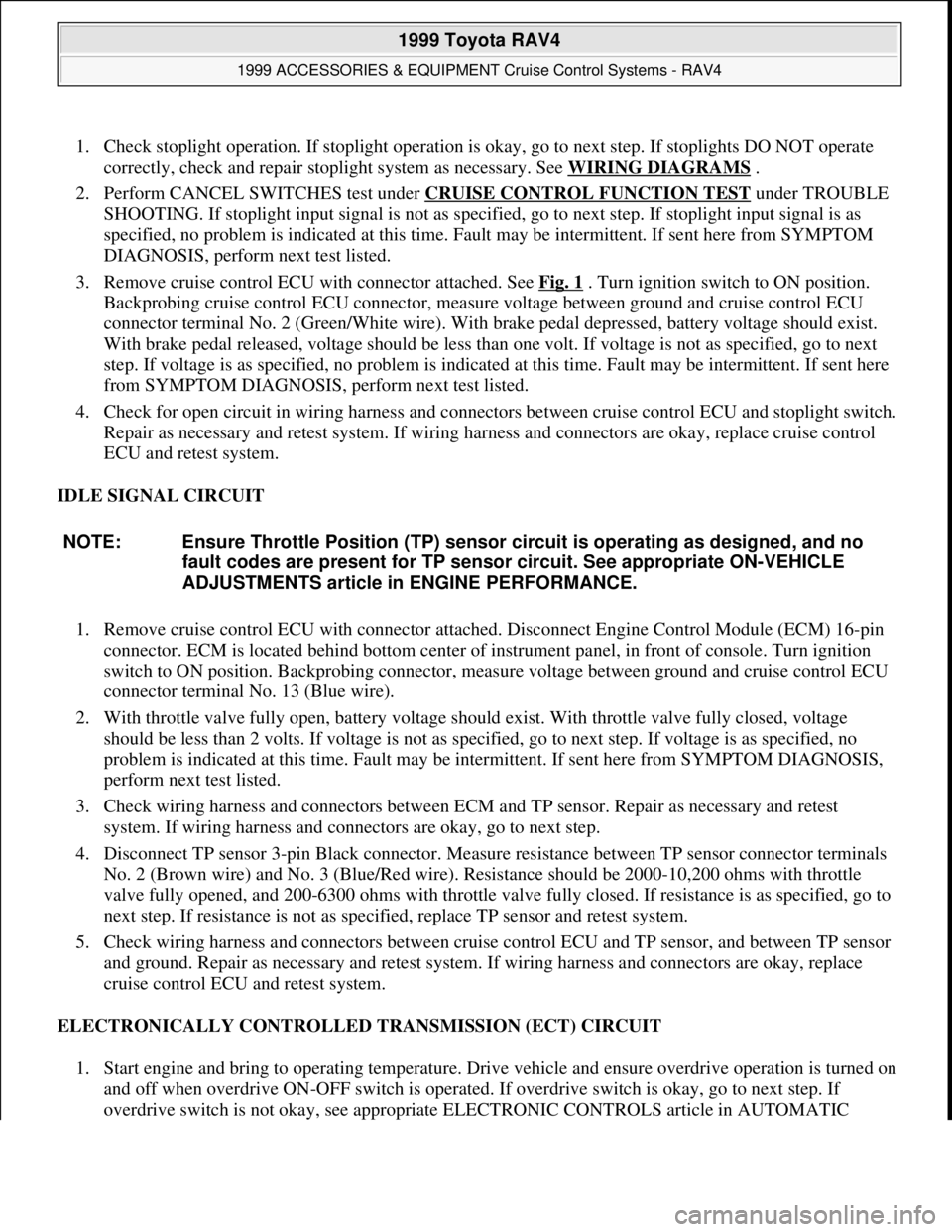
1. Check stoplight operation. If stoplight operation is okay, go to next step. If stoplights DO NOT operate
correctly, check and repair stoplight system as necessary. See WIRING DIAGRAMS
.
2. Perform CANCEL SWITCHES test under CRUISE CONTROL FUNCTION TEST
under TROUBLE
SHOOTING. If stoplight input signal is not as specified, go to next step. If stoplight input signal is as
specified, no problem is indicated at this time. Fault may be intermittent. If sent here from SYMPTOM
DIAGNOSIS, perform next test listed.
3. Remove cruise control ECU with connector attached. See Fig. 1
. Turn ignition switch to ON position.
Backprobing cruise control ECU connector, measure voltage between ground and cruise control ECU
connector terminal No. 2 (Green/White wire). With brake pedal depressed, battery voltage should exist.
With brake pedal released, voltage should be less than one volt. If voltage is not as specified, go to next
step. If voltage is as specified, no problem is indicated at this time. Fault may be intermittent. If sent here
from SYMPTOM DIAGNOSIS, perform next test listed.
4. Check for open circuit in wiring harness and connectors between cruise control ECU and stoplight switch.
Repair as necessary and retest system. If wiring harness and connectors are okay, replace cruise control
ECU and retest system.
IDLE SIGNAL CIRCUIT
1. Remove cruise control ECU with connector attached. Disconnect Engine Control Module (ECM) 16-pin
connector. ECM is located behind bottom center of instrument panel, in front of console. Turn ignition
switch to ON position. Backprobing connector, measure voltage between ground and cruise control ECU
connector terminal No. 13 (Blue wire).
2. With throttle valve fully open, battery voltage should exist. With throttle valve fully closed, voltage
should be less than 2 volts. If voltage is not as specified, go to next step. If voltage is as specified, no
problem is indicated at this time. Fault may be intermittent. If sent here from SYMPTOM DIAGNOSIS,
perform next test listed.
3. Check wiring harness and connectors between ECM and TP sensor. Repair as necessary and retest
system. If wiring harness and connectors are okay, go to next step.
4. Disconnect TP sensor 3-pin Black connector. Measure resistance between TP sensor connector terminals
No. 2 (Brown wire) and No. 3 (Blue/Red wire). Resistance should be 2000-10,200 ohms with throttle
valve fully opened, and 200-6300 ohms with throttle valve fully closed. If resistance is as specified, go to
next step. If resistance is not as specified, replace TP sensor and retest system.
5. Check wiring harness and connectors between cruise control ECU and TP sensor, and between TP sensor
and ground. Repair as necessary and retest system. If wiring harness and connectors are okay, replace
cruise control ECU and retest system.
ELECTRONICALLY CONTROLLED TRANSMISSION (ECT) CIRCUIT
1. Start engine and bring to operating temperature. Drive vehicle and ensure overdrive operation is turned on
and off when overdrive ON-OFF switch is operated. If overdrive switch is okay, go to next step. If
overdrive switch is not okay, see appropriate ELECTRONIC CONTROLS article in AUTOMATIC NOTE: Ensure Throttle Position (TP) sensor circuit is operating as designed, and no
fault codes are present for TP sensor circuit. See appropriate ON-VEHICLE
ADJUSTMENTS article in ENGINE PERFORMANCE.
1999 Toyota RAV4
1999 ACCESSORIES & EQUIPMENT Cruise Control Systems - RAV4
Microsoft
Sunday, November 22, 2009 10:52:01 AMPage 11 © 2005 Mitchell Repair Information Company, LLC.
Page 536 of 1632
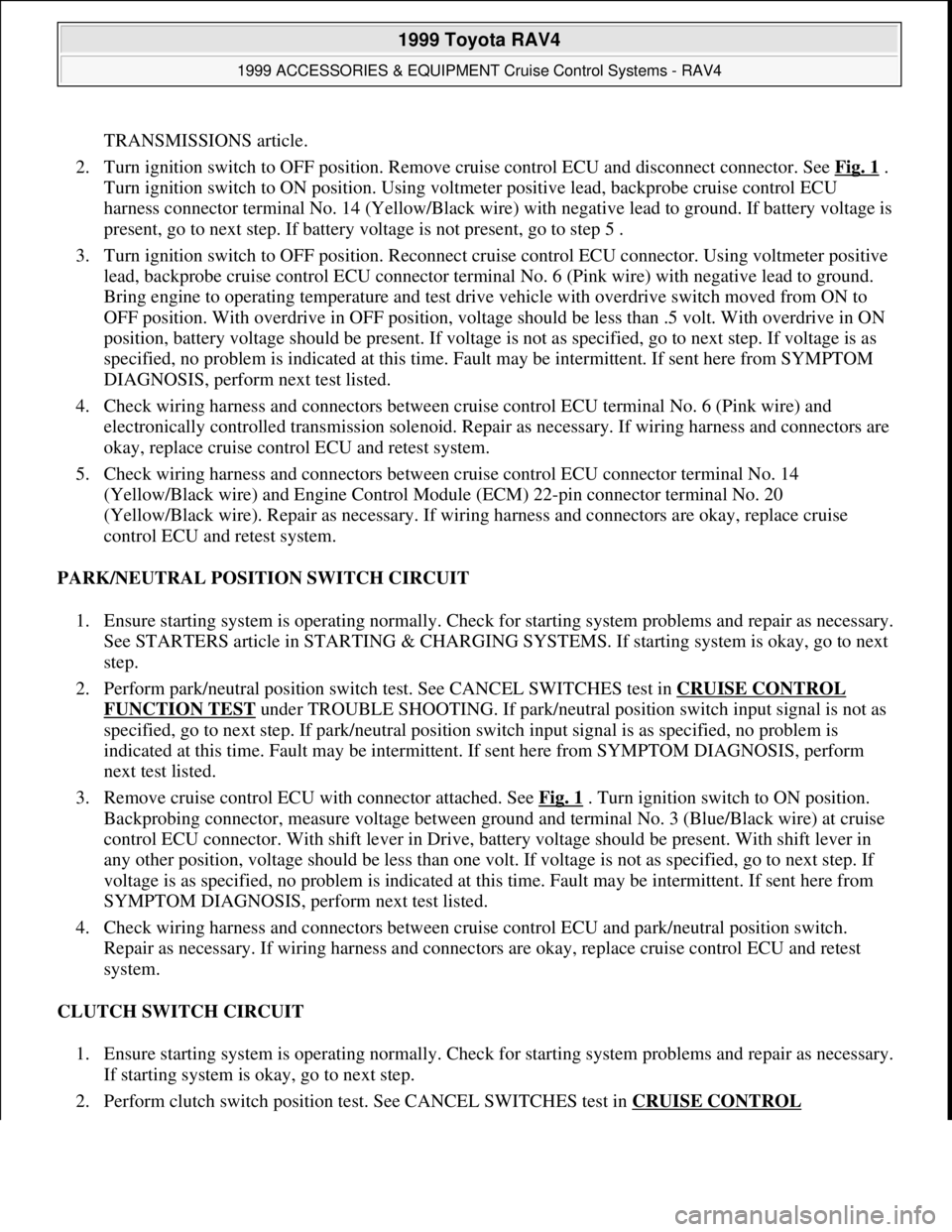
TRANSMISSIONS article.
2. Turn ignition switch to OFF position. Remove cruise control ECU and disconnect connector. See Fig. 1
.
Turn ignition switch to ON position. Using voltmeter positive lead, backprobe cruise control ECU
harness connector terminal No. 14 (Yellow/Black wire) with negative lead to ground. If battery voltage is
present, go to next step. If battery voltage is not present, go to step 5 .
3. Turn ignition switch to OFF position. Reconnect cruise control ECU connector. Using voltmeter positive
lead, backprobe cruise control ECU connector terminal No. 6 (Pink wire) with negative lead to ground.
Bring engine to operating temperature and test drive vehicle with overdrive switch moved from ON to
OFF position. With overdrive in OFF position, voltage should be less than .5 volt. With overdrive in ON
position, battery voltage should be present. If voltage is not as specified, go to next step. If voltage is as
specified, no problem is indicated at this time. Fault may be intermittent. If sent here from SYMPTOM
DIAGNOSIS, perform next test listed.
4. Check wiring harness and connectors between cruise control ECU terminal No. 6 (Pink wire) and
electronically controlled transmission solenoid. Repair as necessary. If wiring harness and connectors are
okay, replace cruise control ECU and retest system.
5. Check wiring harness and connectors between cruise control ECU connector terminal No. 14
(Yellow/Black wire) and Engine Control Module (ECM) 22-pin connector terminal No. 20
(Yellow/Black wire). Repair as necessary. If wiring harness and connectors are okay, replace cruise
control ECU and retest system.
PARK/NEUTRAL POSITION SWITCH CIRCUIT
1. Ensure starting system is operating normally. Check for starting system problems and repair as necessary.
See STARTERS article in STARTING & CHARGING SYSTEMS. If starting system is okay, go to next
step.
2. Perform park/neutral position switch test. See CANCEL SWITCHES test in CRUISE CONTROL
FUNCTION TEST under TROUBLE SHOOTING. If park/neutral position switch input signal is not as
specified, go to next step. If park/neutral position switch input signal is as specified, no problem is
indicated at this time. Fault may be intermittent. If sent here from SYMPTOM DIAGNOSIS, perform
next test listed.
3. Remove cruise control ECU with connector attached. See Fig. 1
. Turn ignition switch to ON position.
Backprobing connector, measure voltage between ground and terminal No. 3 (Blue/Black wire) at cruise
control ECU connector. With shift lever in Drive, battery voltage should be present. With shift lever in
any other position, voltage should be less than one volt. If voltage is not as specified, go to next step. If
voltage is as specified, no problem is indicated at this time. Fault may be intermittent. If sent here from
SYMPTOM DIAGNOSIS, perform next test listed.
4. Check wiring harness and connectors between cruise control ECU and park/neutral position switch.
Repair as necessary. If wiring harness and connectors are okay, replace cruise control ECU and retest
system.
CLUTCH SWITCH CIRCUIT
1. Ensure starting system is operating normally. Check for starting system problems and repair as necessary.
If starting system is okay, go to next step.
2. Perform clutch switch position test. See CANCEL SWITCHES test in CRUISE CONTROL
1999 Toyota RAV4
1999 ACCESSORIES & EQUIPMENT Cruise Control Systems - RAV4
Microsoft
Sunday, November 22, 2009 10:52:01 AMPage 12 © 2005 Mitchell Repair Information Company, LLC.